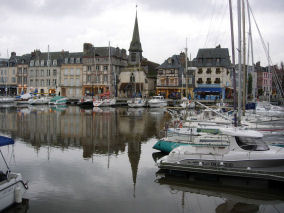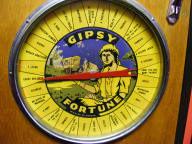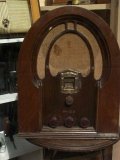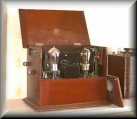SIGNPOSTING
|
Technique for establishing the location at the beginning of a scene - you use FX and sometimes DESCRIPTION - see Description or added words in the dialogue to fill in what is 'blind' for the listener Signposting is like the establishing shot in TV and film. Combine SIGNPOSTING with acoustic and atmos and description and overall 'mise-en-scène' |

FILM SIGNPOSTING - a wide-angle or full shot that sets up the spatial relationships of a scene.
| This gives enough of the location for the adequate telling of the story. It allows the viewer to see what is where. |
| Usually it is an exterior shot - a building in a street, and then is followed by an interior shot (e.g. a couple talking). We realise, putting these together, that the conversation takes place inside the building. |
| FILM SIGNPOSTING gives the cinema audience an overview. They are introduced to the locale and the spatial relationships within it. |
| A re-establishing shot repeats an establishing shot near the end of a sequence. |
RADIO DRAMA - this SIGNPOSTING is a speeded-up version of the equivalent in film.
| Often the listeners are given the location's soundscape. |
| For example, for a conversation outside a shop, passing traffic and people, or on a beach, sea wash and sea birds. |
| A MORE ELABORATE VERSION - one sound event is emphasised, as the call of a sea-bird. You can get over a feeling for the listeners as they start on the scene, linked to the location. |
| You have to establish the location of a scene at the top of the scene, and make this clear to the listener. You probably have to remind your audience of the location of the scene during the dialogue too. See 'mise-en-scène' - representation of the play scene, locations, spaces and perspectives |
| The scene location or scenery is shown by the atmos, as 'open country', 'street with traffic', 'large factory', 'cathedral'. This forms a 'bed' (or 'atmos') underneath the scene dialogue. See Atmos bed |
HOW YOU DO SIGNPOSTING:
| (1) (Usually) fade in location atmos at the top of the scene - as (EXAMPLE) traffic on the High Street, outside Mr. Butcher the Butcher's shop, along with pedestrians walking by, and some chatter. |
| (2) Description - suitably and skilfully in the dialogue, you describe and state where the scene is. EXAMPLES - (approaching) 'And how long have you been waiting outside the butcher's?', or 'Still digging the carrots, Tony?'. |
| RULE: Do not wait around. Do the job of signposting at the top of the scene. Otherwise it will be too late, and the listener will strain to make sense of the atmos, but without the vital clue in the script. |
| RULE: Do not rely on the atmos alone to do the job for you. The atmos may be distinctive - to you - like a bowling alley - but you still have to get that into the scripted dialogue. |
| Remember that film and TV does all this by the establishing shot. Radio drama signposting is the equivalent of that establishing shot and it is as essential. |
| EXAMPLE - Bowling alley - get some activity into the start of the scene and you have a lively and energetic start to the dialogue. 'That's a full strike, Camilla!'. So - description PLUS signposting. |
See also hook - opening 30 seconds.
| Establishing the location of the scene at the top of the scene. See examples of signposting (below). |
| Use FX (sound effects) and often description |
| Signposting is often done before the first dialogue words begin. |

Signposting is a combination
of sound effects (spot or FX pre-recorded), and sometimes backed
by description.
| Most often, the FX (pre-recorded) effects or spot are faded in at the top of the scene, before the dialogue begins. The scene location or scenery is shown by the atmos, as 'open country', 'street with traffic', 'large factory', 'cathedral'. See Atmos bed |
| It is up to the director whether speech begins quickly, or more seconds are needed to strengthen the effect of this signposting on the listener. |
| If a new location, especially an outside location, is being established, the audience will need more time to absorb this information. Examples are the beach with a seagull (though that is a cliché) and the ambience of a crowded street. |
| Spot effects can establish a kitchen: washing up at the sink, or a boiling kettle. |
| Livingroom: teacups or bottles and glasses for alcohol. Acoustic and atmos combine with this. |

| Sometimes the signposting has a relatively simple function, especially in standard production. |
| But it can also be used to indicate mood, as symbolism (in the sense of the iconic/symbolic distinction). |
| Signposting is efficient in returning for the second and further times to the same location. The choice for the director is whether to return to the same signposting device (as washing-up), or vary this. |
| Good writing will link a plot strand to a certain location, for clarity. This is especially to be observed in afternoon plays on BBC R4. For subplot strands, this works well, so that the audience can relocate minor characters in their memory by an easy trigger for recall. |
| For the director, choosing and presenting the signpost is often a task that demands clarity above subtlety or art. It must be immediately 'read' by the listener. |
| Signposting is famous in 'The Archers' where FX birds and animals are regularly used. There is a history of letters in 'Radio Times' of complaints about unseasonal mistakes, as migrating birds heard too early or too late. |
PRODUCTION ADVICE for SIGNPOSTING
| You have to establish the location of a scene at the top of the scene, and make this clear to the listener. You probably have to remind your audience of the location of the scene during the dialogue too. |
| You do signposting by: (1) (Usually) fade in location atmos - as traffic on the High Street, outside Mr. Butcher the Butcher's shop, along with pedestrians walking by, and some chatter. (2) Description - suitably and skilfully in the dialogue, you describe and state where the scene is - (approaching) 'And how long have you been waiting outside the butcher's?', or 'Still digging the carrots, Tony?'. |
| RULE: Do not wait around. Do the job of signposting at the top of the scene. Otherwise it will be too late, and the listener will strain to make sense of the atmos, but without the vital clue in the script. |
| RULE: Do not rely on the atmos alone to do the job for you. The atmos may be distinctive - to you - like a bowling alley - but you still have to get that into the dialogue. |
| Remember that film and TV does all this by the establishing shot. Radio drama signposting is the equivalent of that establishing shot and it is as essential. |
| Bowling alley - get some activity into the start of the scene and you have a lively and energetic start to the dialogue. 'That's a full strike, Camilla!'. So - description PLUS signposting. |
| dog barking | mowing the lawn |
| old-fashioned shop door bell | knock on door |
| walking in street - outside acoustic | inside car acoustic, with traffic |
| boat at sea | beach, quayside - seagulls |
Domestic interior
| tea cups | spirits bottle and glasses, pouring liquid |
| plates and cutlery | kettle boiling and then whistling |
| coffee machine | coffee bean grinder, electric or hand |
| opening lock | chopping vegetables |
| sorting objects from a box |
Machinery
| personal stereo | playing stereo system in living room or bedroom |
| typewriter | portable cassette recorder switched on OR stereo OR music system |
| computer keyboard | vacuum cleaner |
Hand props
opening envelope
towel or clothes

Further, more detailed examples of signposting
| Close acoustic of dining-room, vocal reactions from four male and female adults, spot effects of cutlery on plates. First line: 'It was a magnificent meal, thank you.' |
| Outside acoustic, reaction grunts of male digging energetically. First line (approaching female): 'Still digging the carrots, Tony?' (See record 'umms' from all the characters to store ) |
*
*
* Neutral acoustic, typing on computer. First line: How's the book going, darling?
* Phone booth door opened, close acoustic of phone box, coins put into machine. First line: Hurry up, answer me, answer me, Tom.
* Door of kitchen opened, small room acoustic, opening and shutting cupboards, reaction of male whistling for presence, turns. First line: Stale bread and a half pint of orange juice, no butter.
NOTE:
Atmos bed
| Location and atmos FXs need to be used sparingly throughout the rest of the scene. |
| RULE: Establish this 'bed' of sound effects to let the audience know where the scene is taking place, and then gradually bring this 'bed' down. |
| Also, just nudge it up at bit and then down again, at suitable places in the dialogue that you choose carefully. |
Comments on signposting
Felton, Felix, THE RADIO-PLAY. ITS TECHNIQUES AND POSSIBILITIES
(1949) 42:
All the listener needs is a few pointers, a suggestion from which
he can, as Tyrone Guthrie has put it, "make his own decor",
and the art lies in choosing the effect which will most successfully
get his visual imagination working.
Ditto, 43:
Where more than one effect is used, it is best to introduce them
in stages.
McWhinnie, Donald, THE ART OF
RADIO (1959) 132:
Sense of place is usually important in the radio play, and even
if the dialogue localises a scene, we should not lightly disregard
the imaginative enrichment which fresh, evocative sound provides.
See Crisell, Andrew, 2nd ed.,
1994, Understanding Radio. New York and London: Routledge, page
49 for discussion.
Note that "signposting" as used by Crisell 5 does not
have the same meaning as here.
Assignment on signposting
# Collect a range of examples, for the indoors (kitchen, livingroom,
bathroom and other rooms), the outdoors (urban, suburban and
country) and public and private spaces.
# Collect contrasting examples of iconic signposting and symbolic
signposting.
# Observe their use in 'The Archers'.
# OB fieldwork - collect and record examples.
# Suggest examples to freshen up clichés in radio play
scenes you have heard.

Note about film
An establishing shot is different from a MASTER SHOT.
A Master shot is a shot that could serve as the only shot within a scene. Suppose there were no cutaways or close-ups, then the master shot should be able to carry the whole scene from start to finish.

CONTINUING THROUGH THIS SITE: Description
|
|
||
| establish presence |
|
|
| Perspective |
|
|
|
|
|
|
|
|
|
|
|
|
|
|
|
|
|
|
|
|
|
|
|
|
|
|
|
'moving camera' technique |
|
|
|
'Will you turn that music down!' |
| drop-ins | sound pictures |
|
| number the scenes carefully with a system | voice in the mind = interiorizing |
|
Styles of production, directing and post-production
|
|
|
story board |
|
|
|
|
|
|
Theoretical issues & writing-up your project
|
|
|
|
| language based = logocentric |
|
|
|
|

This site is 'Radio Drama - directing, acting, technical, learning & teaching, researching, styles, genres'. See INDEX to navigate also. Complete curriculum of scripts, techniques (acting & directing & post-production & genre styles), advice, sound files - effects and atmoses (with no copyright and so free to use), detailed script commentaries, etc.
Academic material on this site
is  Alan Beck
is licensed under a Creative Commons Attribution-Non-Commercial-Share
Alike 2.0 UK: England & Wales License.
Alan Beck
is licensed under a Creative Commons Attribution-Non-Commercial-Share
Alike 2.0 UK: England & Wales License.
Learn about radio drama on this site along with my book - Beck, Alan, Radio Acting, London: A & C Black ISBN 0-7136-4631-4 Available on Amazon. CLICK HERE.
To the WELCOME PAGE for Alan Beck's sites. See more of Alan Beck's work.

Any opinions expressed in this site are the personal opinions of the owner of the site. IF YOU HAVE COMMENTS, PLEASE EMAIL TO : [email protected]
